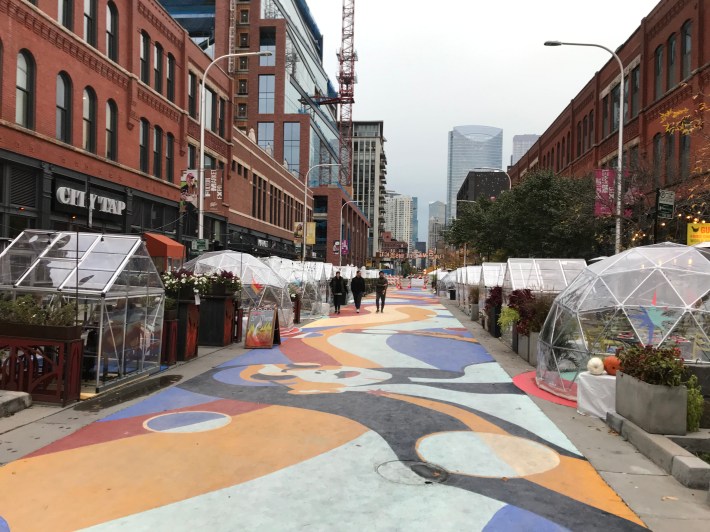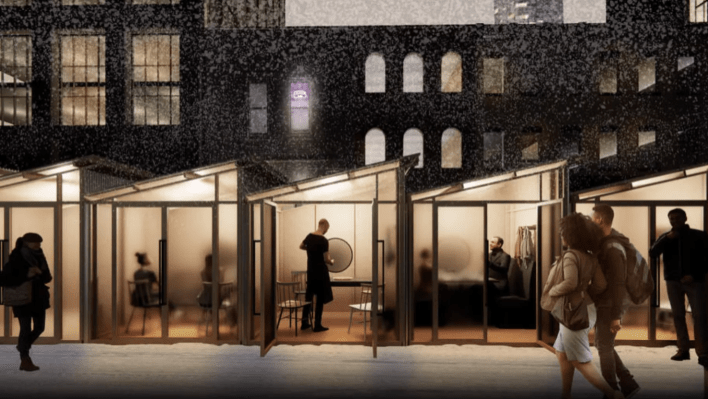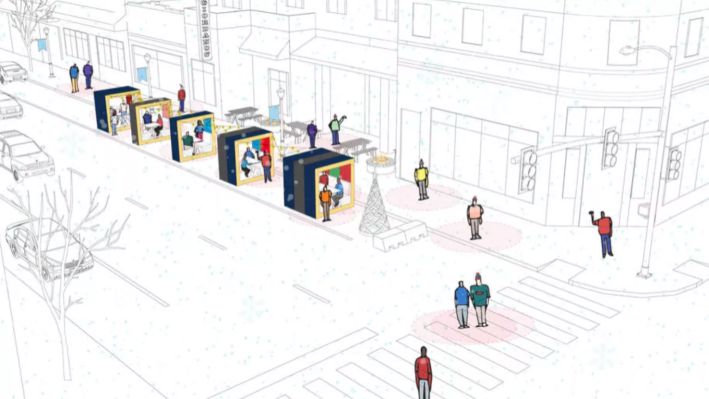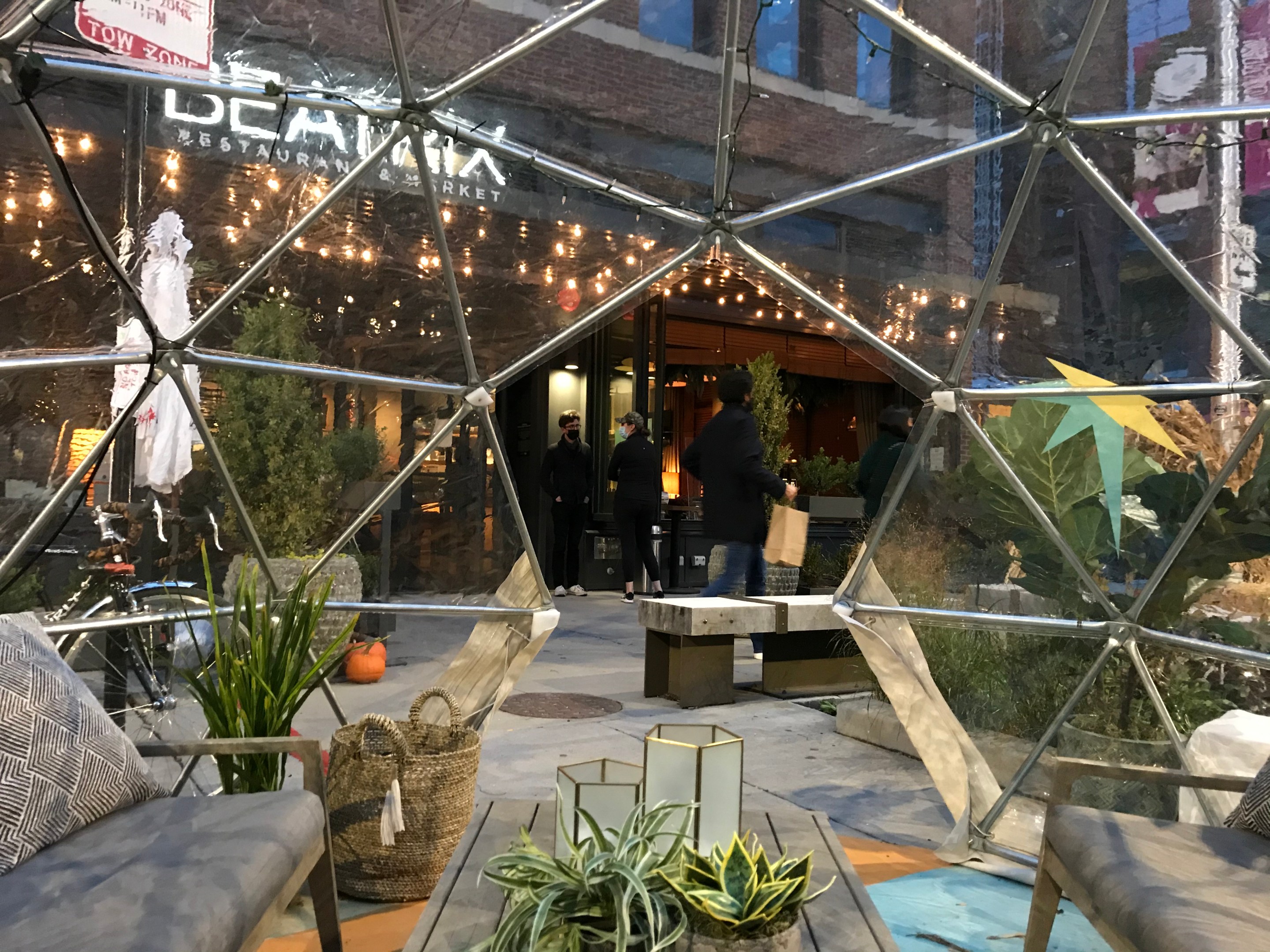Read advice from an infectious disease expert on the relative safety of various sheltered outdoor dining set-ups here.
Dining took to the streets this summer, with restaurants and bars expanding outdoor seating to allow for physically-distanced dining in the freely circulating outdoor air. The city of Chicago supported restaurants' efforts to provide safe dining for guests during the pandemic -- and generate income to help the establishments survive -- by liberalizing the outdoor seating permit system to allow for the expansion of outdoor seating in the public way and parking lots.
Notably the city pedestrianized dozens of restaurant strips, transforming roadways into expansive, people-friendly patios. Over 400 Chicago hospitality businesses expanded their outdoor seating and were able to survive a difficult summer thanks in part to this re-prioritization of public space.
But eating al fresco in Chicago has historically been a two-season activity at best and, with the onset of colder temperatures, restaurants and bars are in an ever-tightening financial bind: how to keep generating income as the pandemic -- and restrictions on indoor dining -- drag into the colder months? Earlier this week Governor J.B. Pritzker announced a total ban on indoor service, starting tomorrow.
The Chicago Department of Business Affairs and Consumer Protection extended outdoor dining permits through the end of 2020, and issued outdoor dining guidelines for the colder months. According to the guidelines, large tents or structures that hold multiple parties must have two of the sides open to allow for sufficient airflow. Enclosed structures may only be used for individual parties and must have “adequate ventilation to allow for airflow.”
Uptown's Green Mill jazz club began hosting outdoor concerts this summer, with bands performing in the adjacent empty storefront while the audience sat on the sidewalk and in the parking lane. The club eventually added an open-sided tent to shelter audience members. Large tents with outdoor heaters, like the ones currently occupying the service drives of the Randolph Street restaurant row, started popping up across the city in late September.

As temperatures continue to drop, dozens of small, enclosed geodesic domes and mini-greenhouses have begun popping up on restaurant patios, sidewalks and pedestrianized streets. On October 16, over twenty of these huts, each furnished with a four-person table or couches and chairs surrounding a coffee table, were installed on the car-free block of Fulton Street between Green and Peoria. There's also a colorful street drawing.
Danielle Coughlin, who manages the Fulton Street tavern The Publican, said the dining enclosures have been a big hit so far. “Even on our slowest evenings we still have bookings for the dome and greenhouses,” she said. Asked about the relative comfort and warmth they provide on October evenings where lows approach freezing, she said, “We encourage guests to dress warmly and recommend they BYOB: bring your own blanket. The enclosures do not have heat, however they do block out the wind, which helps quite a bit.” Coughlin added that as long as guests are comfortable dining outdoors and staff remain safe going to and from the enclosures, Publican will keep them open.

Cannon Porter, a partner with Beatrix, another eatery on Fulton, said the set-up has also been popular with their customers, so much so that they're keeping it in place through New Year's Eve. She added that diners are encouraged to wear masks anytime they're not eating and drinking "and to dine with those they share a household with or feel comfortable dining with." [It's best to avoid hanging out in small enclosed structures with non-household members during the pandemic, and workers shouldn't be required to enter these structures while customers are present. - Editor.]
But it's not clear how much longer unheated outdoor dining will continue to attract customers. In order to find new solutions Mayor Lori Lightfoot, along with the Illinois Restaurant Association and BMO Harris Bank, held a Winter Dining Challenge contest, soliciting designs to keep Chicago diners warm outside and restaurants in business. Three winners were selected from over 600 applicants—two of which imagine some version of the temporary structures for individual parties with a heating element. Notably, both of these designs were modeled to fit in a standard parking space.
(The third winner, a heating implement installed under a low table covered with a blanket, inspired by Japanese kotatsu, is ingenious for its simplicity. I don’t know how warm it can keep a diner seated outdoors in Chicago winter, but the impromptu version I whipped up using a wool blanket and space heater placed under my coffee table revolutionized my workday, seated at a computer in a drafty apartment.)
The “Cozy Cabin” design submitted by ASD|SKY, is inspired by ice fishing huts and is outfitted with radiant floor heat. Three nine-by-nine-foot cabins fit in a standard parking space and the design proposal includes a request the city work with restaurants to provide access to parking spaces.

Neil Reindel’s “Block Party” is a more modular version of a similar concept: brightly colored rectangular frames, each seating two people, can be stacked up next to each other to create seating for any number of diners. Like the “Cozy Cabin,” Reindel’s design fits the depth of a standard parking space, but because each module is narrow, the system is meant to be more flexible and can be arranged in different situations, like lengthwise along sidewalks. Each module is self-contained, including seating, table, lighting and radiant floor heating. Each unit would be on casters, allowing reconfiguration for various parties in a single service.

Isaac Reichman, spokesperson for BACP, said the Illinois Restaurant Association is selecting restaurants to pilot the new designs and the construction and installation costs will be covered by a $35K grant from BMO Harris. Reichman added that the city is working on extending outdoor dining permits into the new year and will consider additional street closure applications that come from businesses, chambers of commerce and business service organizations.
It's encouraging to see efforts to help local restaurants weather a catastrophic storm by reallocating space for cars to space for diners and pedestrians and brainstorming ways to serve diners outdoors year-round. But the reality is, with COVID-19 cases on the rise and no end to the pandemic in sight, Chicago’s hospitality workers and business owners will need significant federal aid, akin to this spring’s CARES act, to survive the most challenging winter they’ve ever experienced.





